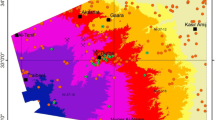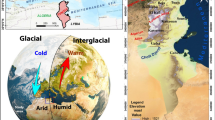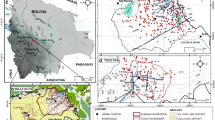Abstract
The current work presents an integrated approach to maximize groundwater exploitation under Sahara conditions. The approach includes investigation of palaeohydrology, remote sensing data, field verification and geophysical datasets (gravity, aeromagnetic and geoloelectrical data). Results reveal the existence of palaeohydrologic remarks such as; palaeodriange, terraces, tufas, gorges and alluvial fans. The hydrogeological investigation reflects that the Quaternary groundwater existed under free water table conditions with water depths range between 5.06 and 50 m from the ground, while the Miocene aquifer has water depths vary between 22 m (of shallow wells) and 108 m (of deep wells). The study illustrates the presence of the tectonic fallen zones (TFZ) where the Precambrian rocks show throw down blocks associated with a set of faults and covered by thick sedimentary succession. The TFZ, with their faults (NW–SE and NE–SW), are attributed to the regional Red Sea rift, where these faults can provide groundwater recharge opportunities. The groundwater occurrences in the TFZ indicate saturation thickness ranges between 75 and 175 m for Miocene aquifer and between 50 and 180 m for Nubian sandstone aquifer. A total of 22 basins were analyzed where their morphometric parameters indicate the possibility of groundwater accumulations. The obtained stable isotopes compositions of hydrogen (δD %) and oxygen (δ18O %) reveal that aquifers were recharged throughout the previous wetter climate with reasonable contributions during intervening arid periods. Due to the continued and urgent need for water in the Sahara, the obtained results can be utilized to develop applied recommendations for future groundwater exploration.















Similar content being viewed by others
References
Abdalla MA, Mekhemer HM, Mabrou WA (2016) The hydrogeological conditions in Sahel Hasheesh, Eastern Desert, Egypt. NRIAG 5:238–246. https://doi.org/10.1016/j.nrjag.2016.02.004
Abdel-Gawad M (1970) The Gulf of Suez-a brief review of stratigraphy and structure. Philos Trans R Soc Lond Ser A Math Phys Sci 267:41–48
Abotalib AZ, Sultan M, Elkadiri R (2016) Groundwater processes in Saharan Africa: implications for landscape evolution in arid environments. Earth Sci Rev 156:108–136
Abotalib AZ, Sultan M, Jimenez G, Crossey L, Karlstrom K, Forman S, Krishnamurth RV, Elkadiri R, Polyak V (2019) Complexity of Saharan paleoclimate reconstruction and implications for modern human migration. Earth Planet Sci Lett 508:74–84
Aero-Service (1984) Final Operational Report of Airborne Magnetic/Radiation Survey in the Eastern Desert, Egypt Conducted for the Egyptian General Petroleum Corporation, Aero-Service Division. Houston Western Geophysical Co., Taxas
Aggur TA, Sadek MA (2001) The Eastern Desert, Egypt. Bull Fac Sci Mansoura Univ 28(1):43–48
Aggour TA, Al Farran SM (2006) The geomorphologic and geologic role in the occurences and development of the water resources in Esh El Malaha area, Easttern Desert, Egypt. In: 8th international conference GAW Cairo Univ., pp 645–662
Akaad MK, Abu El Ela AM (2002) Geology of the basement rocks in the eastern half of the belt between latitudes 25° 30′ and 26° 30′ N. Central Eastern Desert, Egypt. Geol Surv Egypt Cairo 78:1–118
Al-Gamal SA, Hamed Y (2014) Water resources of African Circum-Sahara sub region (renewable and non-renewable approach). J Geol Geosci 3:181. https://doi.org/10.4172/2329-6755.1000181
ASTM American Society of Testing and Materials (2002) Water environmental technology, annual book of ASTM standards, sec. 11.01 and 11.02. U.S.N. West Conshohocken
Badawy MBM (2008) Application of remote sensing and geographic information systems in geomorphological studies, Safaga-El Quseir area, Red Sea Coast, Egypt. PhD thesis Mainz Univ. Germany
Bar-Matthews M (2014) History of water in the middle east and North Africa. Treatise on Geochemistry 2nd Edition. https://doi.org/10.1016/B978-0-08-095975-7.01210-9
Braithwaite CJR (1987) Geology and paleogeography of the Red Sea Region. In: Edwards AJ, Head SM (eds) Red Sea. Pergamon Press, Oxford, pp 22–44
Clarke J (1966) Morphometry from maps, essays in geomorphology. Elsevier Publication, New York
Conoco (1987) Geological map of Egypt, scale 1:500,000. The General Petroleum Company, Cairo
De Hone R (2010) Hydrologic provinces of Mars: physiographic controls on drainage and ponding. Lakes Mars 1:69–89
Drury SA (1993) Image interpretation in geology, 2nd edn. Chapman & Hall, London
El Baz F (1998) Sand accumulation and groundwater in the eastern Sahara. Episodes 21:147–151
EL Shamy IZ (1992) Towards the water management in Sinai Peninsula. In: Proceedings 3rd conference geol. Sinai Development Ismailia, pp 63–70
El Ramly IM (1972) Final report on geomorphology, hydrology planning for groundwater resources and reclamation in Lake Nasser region and its environs. Cen Des Inst. Cairo Egypt
Elsheikh AE (2016) Management of water resources in Wadi Dara area using mathematical modeling for sustainable development, Eastern Desert, Egypt. Egypt J Geol 60:37–59
Foody G, Ghoneim E, Arnell N (2004) Predicting locations sensitive to flash flooding in an arid environment. J Hydrol 292:48–58
Gregory KJ, Willing DE (1973) Drainage basin form and process. Wiley, New York
Hamdan G (1980) The personality of Egypt (in Arabic). 1 Aalam El-Kotob, Cairo
Hamdan MA, Brook GA (2015) Timing and characteristics of Late Pleistocene and Holocene wetter periods in the Eastern Desert and Sinai of Egypt, based on 14C dating and stable isotope analysis of spring tufa deposits. Quat Sci Rev. https://doi.org/10.1016/j.quascirev.2015.09.011
Hamdan MA (2000) Quaternary travertines of the Wadi Abu Had-Dib area, Eastern Desert, Egypt: paleoenvironment through field, sedimentology, age and isotopic study. J Sedimentol Soc Egypt 8:49–62
Hassanein AM, Tarek AA, Ashraf R (2010) New lights on the hydrogeology of Wadi Dara, Western side of the Gulf of Suez, Egypt. Sedimentol Egypt 18:131–146
Horton RE (1932) Drainage basin characteristics transactions. Am Geophys Union 13:350–361
Horton RE (1945) Erosional development of stream and their drainage basins. Geol Soc Am Bull 56:275–330
Issawi B (1983) Ancient rivers of the Eastern Egyptian Desert. Episodes 2:3–6
Ismail YL (2002) Isotopic and hydrological techniques in the study of groundwater origin in the area between Hurghada and Quseir, Red Sea, Eastern Desert, Egypt. Bull Fac Sci Assiut Univ 31(1-F):167–178
Janssen LLF (ed) (2001) Principles of remote sensing: an introductory text-book. ITC, Enschede
Jensen JR (2000) Remote sensing of the environment: an earth resource perspective. Prentice Hall, Upper Saddle River
Jordan G (2004) Terrain modelling with GIS for tectonic geomorphology. ACTA Universitatis Upsaliensis, p 42
Kindermann K, Bubenzer O, Van Peer P (2013) Geo-archaeological research on the Late Pleistocene of the Egyptian Eastern Desert: recent threats to the Sodmein Cave. Antiq Proj Gallery
Kuria D, Gachari M, Macharia M, Mungai E (2012) Mapping groundwater potential in Kitui District, Kenyausing geospatial technologies. Int J Water Res Environ Eng 4(1):15–22
Lillesand TM, Kiefer RW (2000) Remote sensing and image interpretation, 4th edn. Wiley, New York
Madgwick TG, Moon FW, Sadek H (1920) Preliminary geological report on the Abu Shaar El Qibli (Black hill) district. Pet Res Bull 6:1–11
Mahmoud HH (2006) An integrated Geophysical evaluation of groundwater potentialities in the area between wadi Dara and wadi Bali- Red Sea-Egypt. PhD thesis Faculty of Science. Ain Shams University, Egypt
Maidment D (ed) (2002) Arc hydro: GIS for water resources ESRI
Marinova E, Linseele V, Vermeersch P (2008) Holocene environment and subsistence patterns near the tree shelter, Red Sea Mountains, Egypt. Quat Res 70:392–397
Melton MN (1957) An analysis of the relations among elements of climate. Surface properties and geomorphology: project NR 389-042 Tech. Rept. II, Columbia Univ. Depart. of geology, On R, Geog. Branch New York
Mercier N, Valladas H, Froget L (1999) Thermoluminescence dating of a Middle Palaeolithic occupation at Sodmein Cave, Red Sea Mountains (Egypt). J Archaeol Sci 26:1339–1345
Moustafa AR (2002) Controls on the geometry of transfer zones in the Suez rift and northwest Red Sea: Implications for the structural geometry of rift systems. Am Assoc Petrol Geol Bull 86:979–1002
Moeyersons J, Vermeersch PM, Van Peer P (2002) Dry cave deposits and their palaeoenvironmental significance during the last 115 ka, Sodmein Cave, Red Sea Mountains, Egypt. Quat Sci Rev 21:837–851
MPGAP: Mineral, Petroleum and Groundwater Assessment Project (1990) Progressive internal report, unpublished, (1984–1990) prepared by Desert Research Center (DRC)
Murray GW (1951) The Egyptian climate: an historical outline. Geogr J 117(4):422–434
Nag SK, Chakraborty S (2003) Influence of rock types and structures in the development of drainage network in hard rock area. J Indian Soc Remote Sens 31(1):25–35
Nasr IM, Khaled MA, Ez Eldeen HM (2005) Using of geophysical Methods to clarify the hydrogeological setting in Abu Shaar El Qibli area-Red Sea, Egypt. Educ Fac Mag Ain Shams Univ 30:1–12
National Academy of Science and National Academy of Engineering (1972) Water quality criteria. Protection Agency, Washington DC
Pivnik DA, Ramzy M, Steer BL, Thorseth J, El Sisi Z, Gaafar I, Garing JD, Tucker RS (2003) Episodic growth of normal faults as recorded by syntectonic sediments July oil field, Suez rift, Egypt. Am Assoc Pet Geol Bull 87:1015–1030. https://doi.org/10.1306/08220201022
Pohlmann G, Deetz M (1987) Egypt, Atlas for groundwater 1:500,000 Bouguer gravity anomaly map. General Petroleum Company, Cairo
Reynolds ML (1979) Geology of the northern Gulf of Suez. Ann Geol Soc Egypt 9:322–343
Robinson AS, Black S, Sellwood BW, Paul J, Valdes PJ (2006) A review of palaeoclimates and palaeoenvironments in the Levant and Eastern Mediterranean from 25,000 to 5000 years BP: setting the environmental background for the evolution of human civilization. Quat Sci Rev 25:1517–1541
Romberg FE (1958) Key variables of gravity. Geophysics 23:684–700
Sabins FF (1996) Remote sensing, principles and interpretations, 3rd edn. W. H. Freeman & Co., New York
Said R, Issawi B (1964) Geology of Northern Plateau. Bahariya Oasis, Egypt, p 29
Said R (1990) The geology of Egypt. Balkema, Rotterdam
Said R (1993) The Nile River: geology hydrology and utilization. Pergamon, New York
Schmidt C, Kindermann K, Van Peer P, Bubenzer O (2015) Multi-emission luminescence dating of heated chert from the Middle Stone Age sequence at Sodmein Cave (Red Sea Mountains, Egypt). J Archaeol Sci 63:94–103
Schumm SA (1956) Evolution of drainage systems and slopes in badlands at Perth Amboy, New Jersey. Bull Geol Soc Am 67:597–646
Smith KG (1958) Erosional processes and landforms in Badlands National Monument, South Dakota. Geol Soc Am Bull 69:975–1008
Soliman KH (1972) The climate of the United Arab Republic. In: Griffiths JF (ed) World survey of climatology, climate of Africa, 10. Elsevier Publ. Co., Amsterdam, pp 79–92
Sonntag C, Klitzsch E, Loehnert EP, El Shazaly EM, Muennich KO, Junghans Ch, Thorweihe, U, Weistroffer K, Swaleim FM (1978) Palaeoclimatic information from deuterium and oxygene-18 in carbon-14-dated North Saharian groundwaters. In: Isotope Hydrology 1978, Proc. Of Intern. Symp. On Isotope Hydrology, Neuherberg. IAEA, Vienna, pp 569–581
Strahler AN (1964) Quantitative geomorphology of drainage basins and channel networks. In: Chow VT (ed) Handbook of applied hydrology. McGraw-Hill, New York, pp 439–476
Strahler AN (1957) Quantitative analysis of watershed geomorphology. Trans Am Geophys Union 38:913–920
Strahler AN (1953) Quantitative analysis of watershed geomorphology. Trans Am Geophys Union 38:913–920
Sturchio NC, Du X, Purtschert R, Lehmann BE, Sultan M, Patterson LJ, Lu ZT, Müller P, Bigler T, Bailey K, O'Connor TP (2004) One million year old groundwater in the Sahara revealed by krypton-81 and chlorine-36. Geophys Res Lett 31(5):1–4
Sultan M, Yousef A, Metwally S, Becker R, Milewski A, Sauck W, Sturchio N, Mohamed A, Wagdy A, El Alfy Z, Becker D, Sagintayev Z, El Sayed M, Welton B (2011) Red sea rifting controls on aquifer distribution: constraints from geochemical, geophysical, and remote sensing data. Geol Soc Am Bull 123:911–924
Sultan M, Sturchio NC, Gheith H, Hady YA, El Anbeawy M (2000) Chemical and isotopic constraints on the origin of Wadi El-Tarfa ground water, Eastern Desert, Egypt. Ground Water 38(5):743–751
Sultan M, Yan E, Sturchio N, Wagdy A, Abdel Gelil K, Becker R, Manocha M, Milewski A (2007) Natural discharge: a key to sustainable utilization of fossil groundwater. J Hydrol 335:25–36
Sultan M, Wagdy A, Manocha N, Sauck W, Gelil KA, Youssef AF, Becker R, Milewski A, El Alfy Z, Jones C (2008) An integrated approach for identifying aquifers in transcurrent fault systems: the Najd shear system of the Arabian Nubian shield. J Hydrol 349(3):475–488
Szabo BJ, Haynes CV, Maxwell TA (1995) Ages of Quaternary pluvial episodes determined by uranium-series and radiocarbon dating of lacustrine deposits of Eastern Sahara. Palaeogeogr Palaeoclimatol Palaeoecol 113:227–242
Telford WM, Geldart LP, Sheriff RE (1990) Applied geophysics. Cambridge University Press, Cambridge
Vermeersch PM, Linseele V, Marinova E, Van Neer W, Moeyersons J, Rethemeyer J (2015) Early and middle holocene human occupation of the Egyptian Eastern Desert: Sodmein Cave. Afr Archaeol Rev 32:465–503
Wang X, Yin ZY (1997) An evaluation of using ArcInfo to extract basin physiographic parameters from DEMs. https://gis.esri.com/library/userconf/proc97/proc97/to250/pap-215/p215.htm. Accessed 23 Feb 2019
Wasfi S, Azazi G (1979) Stratigraphy of the northern Gulf of Suez. Ann Geol Soc Egypt 9:308–321
World Health Organization: WHO (2011) The guidelines for drinking-water quality, 4th edn. ISBN 978 92 4 154815 1. https://www.who.int. Accessed 4 Dec 2019
Winn RD, Crevello PD, Bosworth W (2001) Lower Miocene Nukhul formation, Gebel el Zeit, Egypt: Model for structural control on early synrift strata and reservoirs, Gulf of Suez. Am Assoc Pet Geol Bull 85:1871–1890
Wood J (1996) The geomorphological characterisation of digital elevation models. Ph.D Thesis, University of Leicester
Younes AI, McClay K (2002) Development of accommodation zones in the Gulf of Suez-Red Sea rift, Egypt. Am Assoc Pet Geol Bull 86:1003–1026
Yousif M, Sracek O (2016) Integration of geological investigations with multi-GIS data layers for water resources assessment in arid regions: El Ambagi Basin, Eastern Desert, Egypt. Environ Earth Sci 75:1–25. https://doi.org/10.1007/s12665-016-5456-1
Yousif M, van Gelder R, Bubenzer O (2016) Hydrogeological investigation of shallow aquifers in an arid data-scarce coastal region (El Daba´a, northwestern Egypt). Hydrogeol J 24:159–179. https://doi.org/10.1007/s10040-015-1308-4
Yousif M, Henselowsky F, Bubenzer O (2018) Palaeohydrology and its impact on groundwater in arid environments: Gebel Duwi and its vicinities, Eastern Desert, Egypt. CATENA 17:29–43. https://doi.org/10.1016/j.catena.2018.06.028
Yousif M (2019) Hydrogeological inferences from remote sensing data and geoinformatic applications to assess the groundwater conditions: El-Kubanyia basin, Western Desert, Egypt. J Afr Earth Sci 152:197–214. https://doi.org/10.1016/j.jafrearsci.2019.02.003
Acknowledgements
The author is very grateful for Orascom Company particularly Engineer Ashraf Helal who provided the technical reports of many groundwater wells in Abu Shaar area. Also, deep thanks to Professor Dr. Hussein Hosny Mahmoud (Geophysical exploration Department, Desert Research Center) for his full support in providing data about geophysical studies and for his valuable advises through the preparing of this study.
Author information
Authors and Affiliations
Corresponding author
Ethics declarations
Conflict of interest
The author declares that the current manuscript has no conflict of interest.
Additional information
Publisher's Note
Springer Nature remains neutral with regard to jurisdictional claims in published maps and institutional affiliations.
Electronic supplementary material
Below is the link to the electronic supplementary material.
Rights and permissions
About this article
Cite this article
Yousif, M. Combination of remote sensing, GIS and palaeohydrologic remarks for promoting the exploitation of water resources in the Sahara: cases from the Red Sea Coast, Egypt. Environ Earth Sci 79, 222 (2020). https://doi.org/10.1007/s12665-020-08977-6
Received:
Accepted:
Published:
DOI: https://doi.org/10.1007/s12665-020-08977-6




